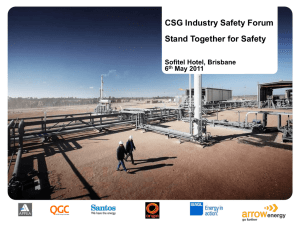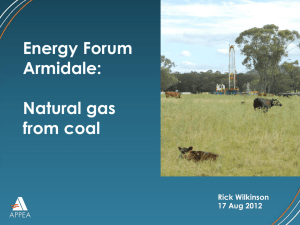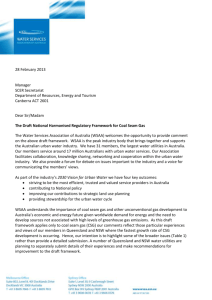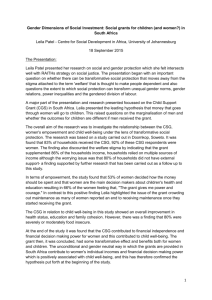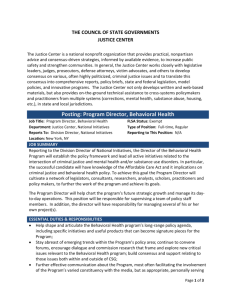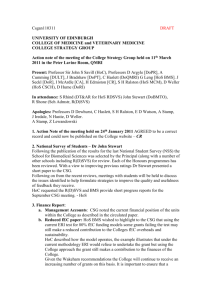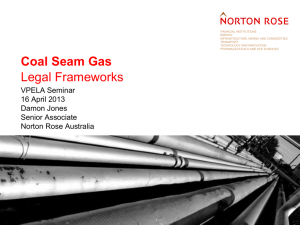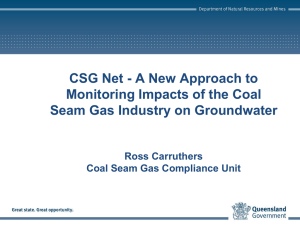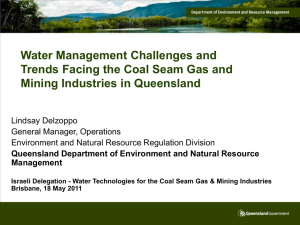Lock the Gate Gippsland, including member groups
advertisement
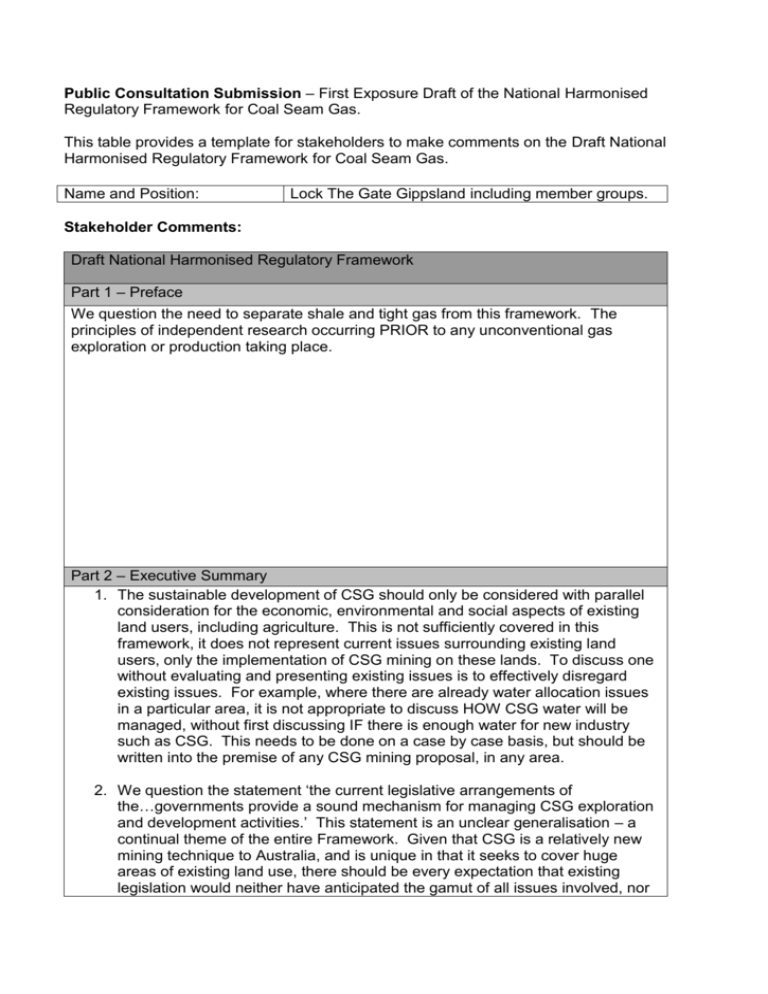
Public Consultation Submission – First Exposure Draft of the National Harmonised Regulatory Framework for Coal Seam Gas. This table provides a template for stakeholders to make comments on the Draft National Harmonised Regulatory Framework for Coal Seam Gas. Name and Position: Lock The Gate Gippsland including member groups. Stakeholder Comments: Draft National Harmonised Regulatory Framework Part 1 – Preface We question the need to separate shale and tight gas from this framework. The principles of independent research occurring PRIOR to any unconventional gas exploration or production taking place. Part 2 – Executive Summary 1. The sustainable development of CSG should only be considered with parallel consideration for the economic, environmental and social aspects of existing land users, including agriculture. This is not sufficiently covered in this framework, it does not represent current issues surrounding existing land users, only the implementation of CSG mining on these lands. To discuss one without evaluating and presenting existing issues is to effectively disregard existing issues. For example, where there are already water allocation issues in a particular area, it is not appropriate to discuss HOW CSG water will be managed, without first discussing IF there is enough water for new industry such as CSG. This needs to be done on a case by case basis, but should be written into the premise of any CSG mining proposal, in any area. 2. We question the statement ‘the current legislative arrangements of the…governments provide a sound mechanism for managing CSG exploration and development activities.’ This statement is an unclear generalisation – a continual theme of the entire Framework. Given that CSG is a relatively new mining technique to Australia, and is unique in that it seeks to cover huge areas of existing land use, there should be every expectation that existing legislation would neither have anticipated the gamut of all issues involved, nor would it sufficiently protect the needs of all stakeholders. For that reason, we would expect that there would and should be new laws to manage this new form of mining. Chapter 1 – Towards Sustainability and Co-existence We question the basic premise of co-existence. It has been neither explained nor justified why there is no option to discuss the concept of mutually exclusive land use. When there is so much clear opposition to the introduction of CSG in prime agricultural areas in the wider community, there needs to be the opportunity to debate the premise that there may, in fact, be areas where the risk posed to existing commerce and land use outweighs the potential benefits of establishing a competing CSG industry. Without this necessary debate, the Framework concerns itself with the details of CSG implementation, but omits the key fundamental question that needs to be discussed in every area where CSG mining is proposed. Public consultation is not true consultation where the paradigm for debate has been arbitrarily limited, for the benefit of the new industry, and to the detriment of the incumbent land users. The nationwide support for the Lock The Gate movement is a categorical statement that a significant population is not calling for ‘safer’ CSG, it is a clear call for no-go zones for the CSG industry. We would suggest that this draft framework is redrafted, and resubmitted for stakeholder submission, with the clear inclusion and discussion of the concept of mutually exclusive land use. The existing framework draft calls for risk minimisation; where independent research can not guarantee that this risk to the existing land use can be adequately measured and or minimised, there needs to be the option for Mutually Exclusive Land Use, either as a temporary or permanent measure. Chapter 2 – Applying Leading Practices We question the notion that the ideal and pursuit of ‘leading practice’ is sufficient to protect all stakeholders, answer their concerns, ‘instil a shared commitment among governments’, and ‘mitigate the potential impacts associated with CSG’. With such an immature industry, leading practice can only refer to ‘the best practice from very short experience’. It neither guarantees the safety of current CSG methods, nor does it seeks to investigate potential issues in the long term. It would be much more realistic to understand the position of a CSG operator from the premise of traditional business – that they have a goal and a responsibility to owners and shareholders of delivering maximum profit from minimum expense. From this, we can confer that any additional cost imposed from either safety or land issue practices is not in the operators best interest, and it would be natural for these operators to minimise these costs and and responsibilities. If we take this premise to be true, we are then left with the need for an independent regulatory body to act as a check and balance against the desire for maximum profit on the part of the CSG operator. This independent regulatory body should have the resources to assess any proposed CSG exploratory area before there is any work done, to establish baseline measurements that later changes may be charted against. This regulatory body should have guaranteed resources that allow it to continue to independently monitor all aspects production throughout the life of a well, or area of wells, and should have the specialist knowledge necessary to evaluate CSG work. It should be able to alter standards and prescribe minimums for mining practice, including retrospective work, as new monitoring and science comes to light. Ideally, it would be independently and proportionally funded from mining royalties – thus its own resources would expand as the industry expands. It should have the ability to halt production on any given site, where there is any question of harm to the existing environment, or existing industry. Action should be preventative and in the event of a lack of data, a conservative approach should be adopted until such time as this data can be acquired and made available for assessment. It should be accountable to the public and required to publically submit results of all monitoring, including breaches of practice, for complete transparency. In short, we should not be relying on CSG operators to police themselves and their processes; rather, a percentage of their profit should be directed to maintaining an independent body acting at arms length from industry. This would then take chief responsibility for monitoring and reporting away from the CSG operator. Chapter 3 – Well Integrity The Key Finding suggests that ‘leading practice in well integrity depends…on consistent compliance by industry and thorough and effective enforcement by qualified regulators.’ Unless the Framework can stipulate a real system that will ensure this compliance, and describe how this enforcement will take place in real-world situations, these ‘findings’ are meaningless. Again, description of any leading practice ensures nothing, without an independent regulator, with no vested interest, to ensure that any one practice takes place, whether it is recognized as leading or otherwise. Chapter 4 – Water Management and Monitoring There is no point recognizing that ‘baseline and ongoing monitoring is critical to informing the development of water impact management strategies’ without describing how this monitoring will take place independently. Again the description of leading practice is irrelevant if there is no compulsion on a profit-driven company to comply and report its compliance with any given regulation. The onus of the checks and balance needs to lie outside the scope of the vested interest of the CSG operator. Chapter 5 – Hydraulic Fracturing As per previous arguments, this practice needs to be independently evaluated on a conservative approach. Unless there is enough uncontested data to determine beyond all possible doubt that it is safe in a particular environment, it should not be utilised as a tool of gas extraction until this uncontested data is available and verified. The cost of evaluation of this independent data should be borne by those interests who stand to make a profit from the technique, ie the CSG operator. Given the current doubt placed on its safety from other industrialised countries, we should be adopting a default position of conservative safety, given the potential for widespread impacts in the future that may last long beyond any potential productive period of a given CSG region. Chapter 6 – Chemical Use Unless there is continual and unrestricted access by an independent body to any given site for the purposes of chemical monitoring, there is no way to confirm that any CSG operator is willingly compromising their own profits for the sake of maintaining leading practice. The difficulty of downstream monitoring of chemical use means that there is a tremendous opportunity for any given operator to adjust their chemical use as they see fit, with consideration being given only to their needs and drilling requirements. Unless there is a real, independent body that has the power and resources to approve, regulate and monitor widespread drilling and production practice, we are again left in the undesirable position of having to trust and rely on a private profit-driven company for community safety. Other issues
